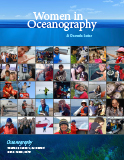Article Abstract
Women began to join US oceanographic expeditions in about 1960, contemporary with the modern women's rights movements in the industrialized world. Female representation in academic research has increased since then, but the ratio of women to men at higher ranks in oceanography still lags, even though women have comprised roughly half of oceanography graduate students during the past decade. Here, we examine recent trends in the representation of women in oceanography, highlighting indicators of under-representation among oceanographic faculty and chief scientists of oceanographic expeditions, and also noting positive signs of improvement. We discuss modern challenges to women in academic science, and oceanography in particular, and how they influence the career choices of women in oceanography. We provide recommendations for overcoming internal and external obstacles to career success that should be useful to students and early career women oceanographers as well as search committees, deans, department chairs, and program managers who have the power to hire and promote female colleagues.

